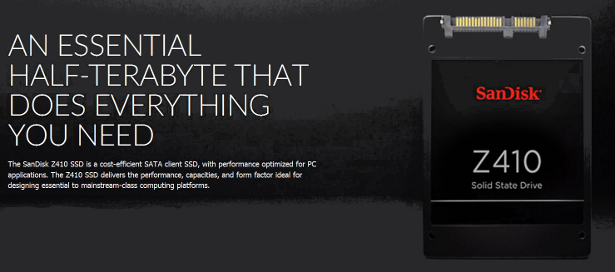SanDisk Corporation, a world-leading producer of flash storage devices, is announcing the SanDisk Z410 SSD, a competitively priced solid-state drive (SSD) that allows OEMs to incorporate it into a broad range of laptops and desktop PCs. The Z410 features 15nm three-bits-per-cell (TLC) NAND, enabling the performance, capacities and form factor that are easily incorporated into most mainstream computing platforms.
 The Z410 is built on the successful SanDisk Z400s platform, and features an SLC cache, which combines SLC and TLC blocks to improve read and writes speeds. This means that users can expect faster start-up times and application loading, which makes the Z410 an excellent choice for multi-tasking and typical PC workloads, including web browsing, email, home/office productivity, audio/visual entertainment and casual gaming.
The Z410 is built on the successful SanDisk Z400s platform, and features an SLC cache, which combines SLC and TLC blocks to improve read and writes speeds. This means that users can expect faster start-up times and application loading, which makes the Z410 an excellent choice for multi-tasking and typical PC workloads, including web browsing, email, home/office productivity, audio/visual entertainment and casual gaming.
 According to Tarun Loomba, SanDisk’s vice president and general manager of Client Platform Solutions, “SSDs are being rapidly adopted as the preferred storage option across the entire spectrum of the PC marketplace. In addition to the performance and durability benefits that SSDs provide, the SanDisk Z410 SSD delivers storage that is ample for most consumers and the right-size for typical corporate users. The Z410 is an important addition to our overall SSD portfolio, as our customers require a complete range of storage options, from home/office PCs to the latest high-performance, ultra-thin laptops.”
According to Tarun Loomba, SanDisk’s vice president and general manager of Client Platform Solutions, “SSDs are being rapidly adopted as the preferred storage option across the entire spectrum of the PC marketplace. In addition to the performance and durability benefits that SSDs provide, the SanDisk Z410 SSD delivers storage that is ample for most consumers and the right-size for typical corporate users. The Z410 is an important addition to our overall SSD portfolio, as our customers require a complete range of storage options, from home/office PCs to the latest high-performance, ultra-thin laptops.”
 With capacities of up to 480GB, the Z410 is a great choice for manufacturers looking to design durable and energy-efficient computing devices. The Z410 has already been validated for several top OEM platforms, and is designed to deliver consistently high endurance and reliability for typical home, educational and corporate applications. The Z410 SSD boasts a Mean Time Between Failures (MTBF) of up to 1.75 million hours, allowing SanDisk to back it to the tune of a three-year limited warranty. The Z410 also features one of the lowest power draws of any SSD in the industry, consuming less power in both active and low-power/slumber modes.
With capacities of up to 480GB, the Z410 is a great choice for manufacturers looking to design durable and energy-efficient computing devices. The Z410 has already been validated for several top OEM platforms, and is designed to deliver consistently high endurance and reliability for typical home, educational and corporate applications. The Z410 SSD boasts a Mean Time Between Failures (MTBF) of up to 1.75 million hours, allowing SanDisk to back it to the tune of a three-year limited warranty. The Z410 also features one of the lowest power draws of any SSD in the industry, consuming less power in both active and low-power/slumber modes.
 The Z410 is being offered in capacities of 120GB, 240GB and 480GB – all in the standard 2.5” x 7mm form factor. Sequential read speeds are stated as 535 MB/s for all capacities, with sequential write speeds of 410 MB/s (120GB), 440 MB/s (240GB), or 445 MB/s (480GB). Random 4K read speeds are stated as 36,000 IOPS for the 120GB and 240GB versions, and 37,000 IOPS for the 480GB model. Random 4K write speeds are stated at 54,000 IOPS for the 120GB, 66,000 IOPS for the 240GB, and 68,000 IOPS for the 480GB model.
The Z410 is being offered in capacities of 120GB, 240GB and 480GB – all in the standard 2.5” x 7mm form factor. Sequential read speeds are stated as 535 MB/s for all capacities, with sequential write speeds of 410 MB/s (120GB), 440 MB/s (240GB), or 445 MB/s (480GB). Random 4K read speeds are stated as 36,000 IOPS for the 120GB and 240GB versions, and 37,000 IOPS for the 480GB model. Random 4K write speeds are stated at 54,000 IOPS for the 120GB, 66,000 IOPS for the 240GB, and 68,000 IOPS for the 480GB model.
 For more information, you can view the SanDisk Z410’s product page here; and the press release announcing it in its entirety here.
For more information, you can view the SanDisk Z410’s product page here; and the press release announcing it in its entirety here.
 The SSD Review The Worlds Dedicated SSD Education and Review Resource |
The SSD Review The Worlds Dedicated SSD Education and Review Resource | 
waiting for pcie to drop in price to get real speed
Waiting for 3D flash to get rid of this 2d tlc trash. This shouldn’t be put in ssds.
This SSD is good enough for consumer use. I understand there’s a need for speed but for all consumer scenarios every single SSD will be good enough, no matter if we’re talking about SATA MLC SSD from 2010, or SATA TLC SSD from 2015 or the newest NVMe drive. If there’s enough qualification and FW/flash knowledge at the suppliers side, even 15nm TLC will be good for many years to come. 3D TLC is not yet mature and you won’t even feel the difference between 3D or 2D NAND for the consumer application. I won’t even mention that some companies are mixing 3D and 2D NAND within one product line, because yield of 3D is very low and they both meet tech specs.